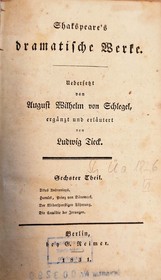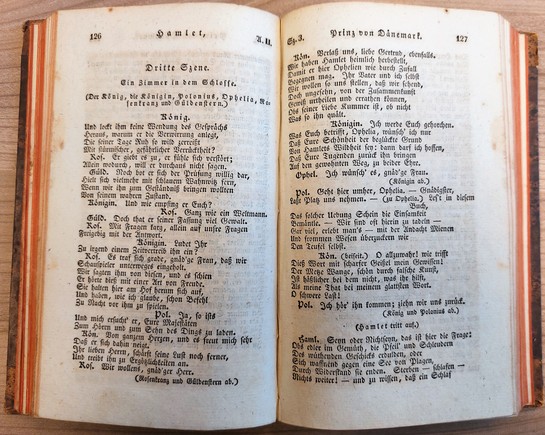Schlegel-Tieck Hamlet
August Wilhelm Schlegel & Ludwig Tieck: The Hamlet Translation
The Schlegel-Tieck translation of Shakespeare’s plays is a key publication within the German-speaking Shakespeare reception. It is of interest not simply as a work that makes Shakespeare’s drama accessible to German-speaking readers, but also as a document that raises important questions about the task of the translator and the translator’s impact on the text and its reception.

August Wilhelm Schlegel, whose Hamlet translation formed the textual basis for the 1831 edition of which the LMU’ Shakespeare research library holds a copy, aimed for a faithful mediation of form, meter, and imagery in the first instance. In order to achieve this, Schlegel’s translation is not always a literal word for word translation, but allows for some poetic licence and flexibility in order to faithfully reproduce the blank verse found in Shakespeare:
Hamlet 1.2.61: I do beseech you, give him leave to go.
Schlegel’s translation: Ich bitt’ Euch, gebt Erlaubnis ihm zu gehn.
While the faithful rendition of blank verse and its rhythm appears to have been one of Schlegel’s main aims, an exact reproduction of the meter in each line was sometimes difficult to achieve as English contains more monosyllabic words than German. This condition sometimes led to a necessary adjustment of line length and rhythm within the German translation. Schlegel’s translation also harmonises some distinctive line breaks and breaks in meter that can be found in Shakespeare’s text. Consider, for instance,
Hamlet 2.2.85: This business is well ended. — [half line]
Schlegel’s translation: So wäre dies Geschäft nun wohl vollbracht [full line]
The translation noticeably uses more filler words which, in turn, harmonise the meter and change the original half line into a full line. The rhythmic irregularities and breaks in meter are glossed over in the German translation. The translation’s tendency to render the English text into a more harmonic, regular shape and verse length notably produces fewer moments of linguistic, rhythmic and (arguably) psychological upheaval. As outlined in the previous blog post, Tieck further altered and amended the text by Schlegel. One of the biggest changes that Tieck introduced to the 1831 edition of Hamlet is an adjustment of the length of acts by changing which scenes belong to which act in the play: Act II comprises of three scenes in Tieck’s arrangement, but only of two in the original text. Similarly, Act III comprises of five scenes in the German translation, but only of four in the English original. The biggest change has been introduced to Act IV, which Tieck cut down to four scenes (whereas the original text contains seven scenes in Act IV).

Tieck himself suggested in his writings on theatre (“Dramaturgische Blätter”) that this re-arrangement of scenes and his adjustment to the length of individual acts would produce a more coherent and therefore also a more accessible play for the audience. He moves, for instance, Hamlet’s famous “To be or not to be” soliloquy from III.1 to the newly established II.3 in order to achieve a link between this key speech and Hamlet’s previous soliloquy in II.2. The changes undertaken by Tieck help to clarify his view of the task of the translator not simply as providing a careful word for word rendition, but as creating and facilitating a play that achieves clarity and coherence dramaturgically, poetically, and linguistically.
These examples show briefly how both Schlegel and Tieck made individual changes to Shakespeare’s Hamlet and these alterations certainly reflect their own agenda and their understanding of translation not simply as a process of mediation from English into German, but as a poetic and dramaturgical undertaking in its own right. Our modern readings of the Schlegel-Tieck translation may vary from admiration to assessments of the work as overly romantic, classicist, or simply as taking too much poetic licence. Yet, regardless of how we choose to evaluate the Schlegel-Tieck translation from our twenty-first century point of view, the literary-historical importance of their work, the sheer scale of their undertaking, and their achievement of making Shakespeare widely accessible to German-speaking readers and actors for almost two centuries remains undisputed.

